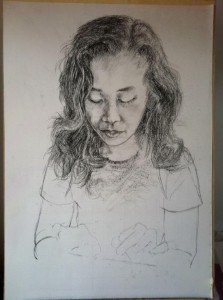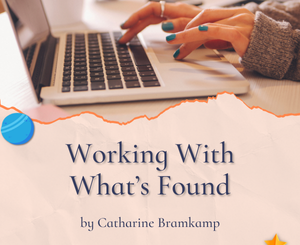Inspiration for Writers: Drawing from Life
Enjoy this inspirational guest post from Ien Nivens.
***
Art: “MeLADY” by Azali Rahim, graphite on paper, 2012
At the age of twelve, I started thinking of myself as a visual artist. Most of the formal training I’ve sought out as an adult has been in making images and teaching others how to make images. No sooner did I earn a degree in Art Education, however, than I started creating narrative instead of literal imagery—that is, I started writing the stories that had been brewing under the surfaces of my drawings and paintings.
I’m as much a visual artist as I ever was, I like to tell myself. I’ve just traded my brush for a keyboard and my pigments for a palette of words. I’ve given up trying to make anything like a point-by-point analogy between writing and drawing, but from time to time, I do find lessons for one kind of artist in the work of another.
Take, for example, the gentle rendering called “meLADY” by Malaysian artist Azali Rahim (find him on Facebook at https://www.facebook.com/azalirahim). At first blush, the drawing provides a straightforward example of portraiture—a “character study,” if you will. We find a serious girl, pre-adolescent, who is not willing to engage with us directly—at least, not at the moment. Winsome as she is, she does not concern herself too much with her appearance. She may be shy, but there’s more to it than that; she’s busy. Gradually, a narrative emerges. Her story informs her character and vice versa.
What I find instructive to the art of verbal storytelling, though, is in the way Rahim presents his details. Notice how much attention he gives to the girl’s face, to her hair and facial features. Look at the set of her mouth. Here is a girl with a rich interior life—absorbed, but not self-absorbed. We can see this in her hair. Unkempt but not wild, it shields her face a little, but not so much that it gets in her way. We do not see her eyes, but we know that she hasn’t closed them, and we can’t help but follow her gaze down the page. At a glance, the information—the marks, the effort that has gone into making the image—occupies the top half of the visual space. The composition seems deliberately top-heavy. And so, in the very act of drawing, Rahim gives us who she is and what she’s about: meLADY lives in her head.
We note and dismiss the crew neck and texture of her tee shirt, gliding over the narrow chest and size of her body relative to her head (which confirms both her age and her temperament) and the way she tucks her elbows in against her sides. Developmentally, she is at that “serious” age—between eight and eleven—at which we cease to rely on instinct and charm and begin to exercise the independence that comes with the acquisition of skill sets we’ll need to use in adulthood. All of this goes as if without saying, but in fact it is stated—in passing. We are on our way—drawn by our eyes—to the discovery this drawing holds for us—that is, to the one piece of information that the artist withholds: the keyboard.
We’ve known all along what she’s doing, of course. We just didn’t know quite how we knew. She holds the miracle of this little drawing in her left hand, in the curl of her fingers to keep from striking the wrong key. Because in spite of the state of her hair, she is a meticulous child. And in spite of the apparent lack of detail, the artist has meticulously presented us with just what we need and not one stroke more. We see the keyboard—a particularly vital part of the story—even though it is hardly indicated. We even see (and feel!) the pad of the ring finger of her right hand as it depresses the “o” key (can it be any other?)—none of which is drawn for us!
Traveling back across the intervening space to her expression, we see her concentration again and know that she has tuned us out. From her downward gaze, we might intuit any number of things: a world wide web of possibilities, stories, conversations, connections. And we understand that, from half a globe away, Rahim has drawn one of us: a writer engaged in her craft.
I could make more explicit the lessons contained in this quiet gem of a portrait and how they apply to back story, information overload, sensual detail and so on, but if the artist has anything to teach me as a writer and a teacher, it is to trust my audience to take for themselves those leaps that are both obvious and essential.
***
 Ien Nivens, freelance web and graphic design consultant and author of The American Book of Changes, believes that engaging metaphors drive transformative work, lives and relationships. Engage with him on Facebook or at figur8ively at AOL dot com.
Ien Nivens, freelance web and graphic design consultant and author of The American Book of Changes, believes that engaging metaphors drive transformative work, lives and relationships. Engage with him on Facebook or at figur8ively at AOL dot com.







